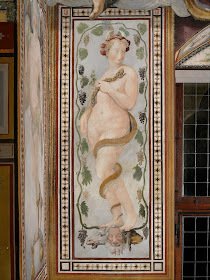 |
| Francesco Salviati Sala dell'Udienza Ornamental Ignudi ca. 1543-45 fresco Palazzo Vecchio, Florence |
 |
| Francesco Salviati Sala dell'Udienza Sala dell'Udienza ca. 1543-45 fresco Palazzo Vecchio, Florence |
 |
| Francesco Salviati Sala dell'Udienza Sala dell'Udienza ca. 1543-45 fresco Palazzo Vecchio, Florence |
"Idealization – In theory, idealization in art is a means of elevating representation from the particular to the general, from relative to absolute significance. Its justification derives from the Platonic theory of Ideas. Plato asserts that only Ideas (perfect forms existing in the Divine Intellect and apprehended through the human intellect) are real; phenomena which are evident to the senses are shadows or distortions of the Ideas. Idealization is an integral part of academic theory and practice in Western art. Sir Joshua Reynolds's Third Discourse to the Royal Academy (1770) sets out the clearest academic prescription for idealization: The painter's eye being enabled to distinguish the accidental deficiencies, excrescences and deformities of things, from their general figures, he makes out an abstract idea of their forms more perfect than any one original."
– Erika Langmuir and Norbert Lynton, The Yale Dictionary of Art and Artists (2000)
 |
| Francesco Salviati Sala dell'Udienza Ornamental Ignudo ca. 1543-45 fresco Palazzo Vecchio, Florence |
 |
| Francesco Salviati Sala dell'Udienza Ornamental Ignudo ca. 1543-45 fresco Palazzo Vecchio, Florence |
 |
| Francesco Salviati Sala dell'Udienza Ornamental Ignudo ca. 1543-45 fresco Palazzo Vecchio, Florence |
 |
| Francesco Salviati Sala dell'Udienza Ornamental Ignudo ca. 1543-45 fresco Palazzo Vecchio, Florence |
"Nude – A form of representation which is of special importance in the history of Western art, having become in Graeco-Roman antiquity a prime vehicle for idealization. A nude differs from the representation of a naked human being in that it suppresses individual resemblance and particular circumstances in favour of harmonious, or abstract, design and timeless generalization."
– Erika Langmuir and Norbert Lynton, The Yale Dictionary of Art and Artists (2000)
 |
| Francesco Salviati Sala dell'Udienza Framing Figure of Kairòs (Opportunity) ca. 1543-45 fresco Palazzo Vecchio, Florence |
 |
| Francesco Salviati Sala dell'Udienza Framing Figure of the Goddess Hecate ca. 1543-45 fresco Palazzo Vecchio, Florence |
 |
| Francesco Salviati Sala dell'Udienza Framing Figure of the Arno ca. 1543-45 fresco Palazzo Vecchio, Florence |
 |
| Francesco Salviati Sala dell'Udienza Framing Figure of Fortune ca. 1543-45 fresco Palazzo Vecchio, Florence |
 |
| Francesco Salviati Sala dell'Udienza Framing Figure of the Goddess Diana ca. 1543-45 fresco Palazzo Vecchio, Florence |
 |
| Francesco Salviati Sala dell'Udienza Framing Figure of the God Mars triumphing over a Gaul ca. 1543-45 fresco Palazzo Vecchio, Florence |
 |
| Francesco Salviati Sala dell'Udienza Framing Figure of the God Mars triumphing over a Gaul ca. 1543-45 fresco Palazzo Vecchio, Florence |
 |
| Francesco Salviati Sala dell'Udienza Allegory of Peace ca. 1543-45 fresco (grisaille) Palazzo Vecchio, Florence |
 |
| Francesco Salviati Allegory of Peace Design for Sala dell'Udienza Palazzo Vecchio, Florence ca. 1543-45 drawing Harvard Art Museums |
"Francesco Salviati – Florentine-born Mannerist painter, mainly of outstanding fresco cycles but also of altarpieces, tapestry designs and portraits. His style was formed less during his Florentine training than through his enthusiastic studies, part of the time with his friend and chronicler Vasari, of High Renaissance and earlier Mannerist art in Rome. . . . Salviati's brand of Mannerism is far more than a formula for ordering pictorial composition and aestheticizing the human form. It is apparent also in his attitude to partitioning the wall surface of his mural decorations: no painter is more inventive or revels more in playful alternations of levels of reality, perceptual puzzles and witty allusions to earlier art."
– Erika Langmuir and Norbert Lynton, The Yale Dictionary of Art and Artists (2000)